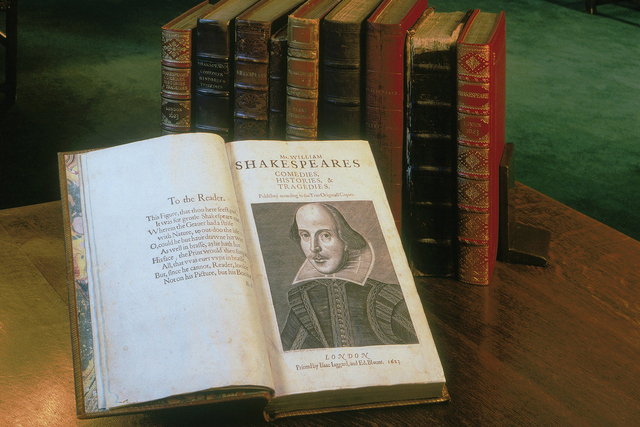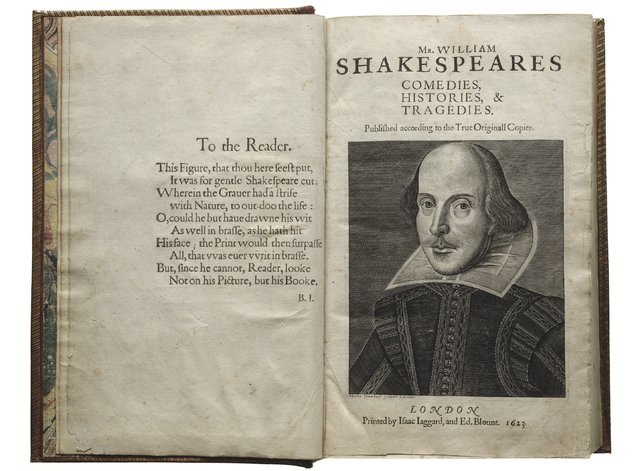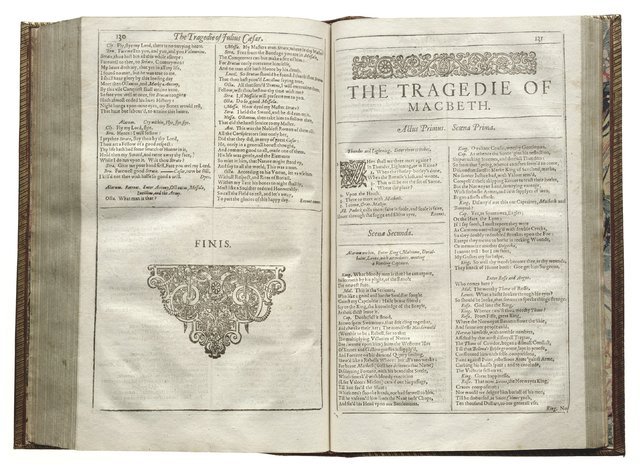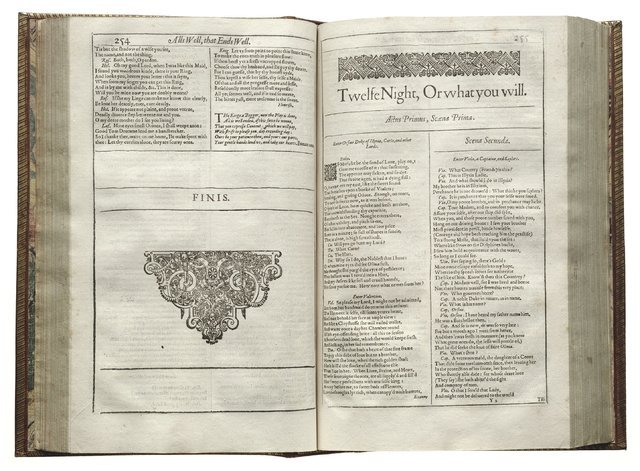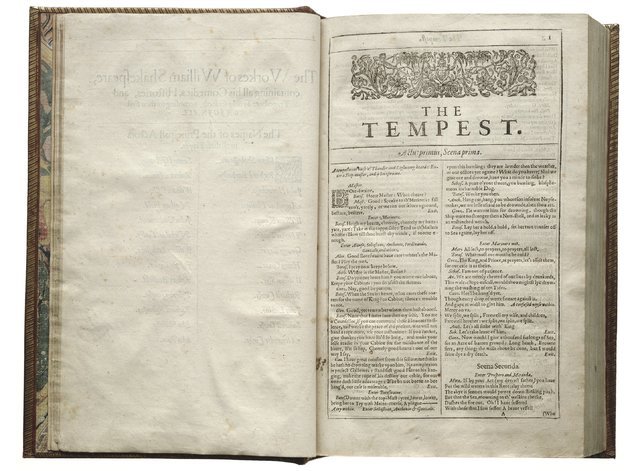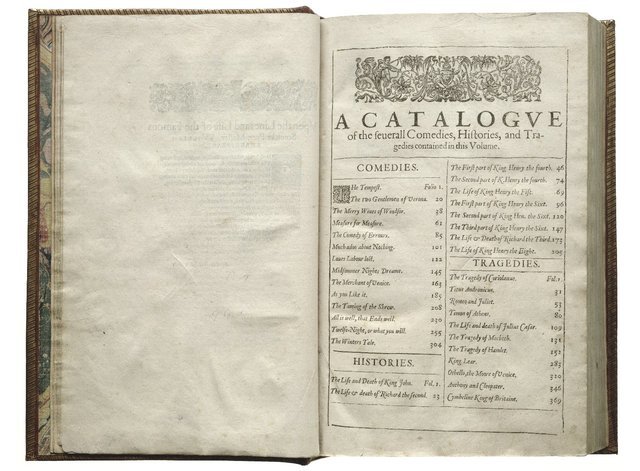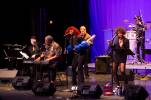Shakespeare’s First Folio makes monthlong stop at UNLV
As Hamlet said, “Words, words, words.”
But not just any words.
Recall the passage that begins “All the world’s a stage … ” Or “We are such stuff as dreams are made on.”
Need more? “If music be the food of love, play on.” How about “Et tu, Brute?” or “It is a tale told by an idiot, full of sound and fury, signifying nothing.”
The significance of those lines, from those plays by William Shakespeare (“As You Like It,” “The Tempest,” “Twelfth Night,” “Julius Caesar” and “Macbeth,” respectively), can’t be underestimated.
And without the First Folio — a 1623 volume in which the aforementioned plays made their first appearance in print — we might not know, and remember, any of them.
Yet four centuries after the Bard’s death, Shakespeare’s words, and works, remain as alive as ever.
Las Vegans will have the chance to peruse the volume that introduced those plays as “First Folio! The Book That Gave Us Shakespeare” continues on display in the special collections department — on the third floor of UNLV’s Lied Library — through Sept. 29.
Thursday’s preview includes scenes from “Bomb-itty of Errors,” a hip-hop version of “Comedy of Errors” — another First Folio debut — that opens Nevada Conservatory Theatre’s 2016-17 season Friday at UNLV’s Judy Bayley Theatre.
The UNLV visit is part of a national tour (all 50 states, plus Washington, D.C., and Puerto Rico) presented by Washington, D.C.’s Folger Shakespeare Library, which owns 82 of the 235 existing folios.
The tour’s one-visit-per-state limit means the UNLV stop is the only Nevada appearance for the bound volume, which marked the print debut of 18 plays — and the reprint of 18 previously published, during Shakespeare’s lifetime, in cheap paperback editions known as quartos.
Almost 400 years after its debut, the First Folio is anything but cheap; Microsoft co-founder Paul Allen paid $6 million for one at a 2001 auction.
“It’s always been an object only the ultra-rich could afford,” notes Eric Rasmussen, chairman of the English department at the University of Nevada, Reno.
Rasmussen’s the go-to guy when it’s time to authenticate a newly discovered First Folio — as he did in 2014 when one was discovered in a French public library. News of the find went viral, triggering 12.5 billion online page views; he’ll lecture on the discovery, and the reaction, at UNLV on Sept. 18.
Author of “The Shakespeare Thefts: In Search of the First Folios,” Rasmussen has seen volumes that bear definite signs of their centuries of existence, from wine stains and cat footprints to a child’s scrawled ABCs. (One found in Japan even has a musket-ball hole.) But these idiosyncrasies are “so humanizing,” he comments.
To prepare for the folio’s Las Vegas appearance, UNLV officials had to “lower the temperature and raise the humidity” to create “the perfect climate” for the display, explains Michelle Light, director of special collections.
“There was about a month where we were investigating what it would take to say yes” to welcoming the tour, she recalls.
What it took: increasing the humidity in the Special Collections reading room to more than 30 percent, reducing the temperature to between 69 and 71 degrees, blacking out windows and lowering light levels, all to protect the 393-year-old volume.
“Facilities management has done an exceptional job addressing each of the requirements to prepare Special Collections for the exhibit,” according to Light.
Although the folio marks the debut of several Shakespeare classics, the volume (encased in glass) will be opened to a page featuring an old friend: the first scene of “Hamlet’s” Act III, featuring the immortal soliloquy that begins “To be, or not to be … ”
It’s “the default position,” according to Dan Decker, director of the Shakespeare Institute of Nevada, which will present scenes from “A Midsummer Night’s Dream,” “Macbeth” and “Romeo and Juliet” at the library Sept. 11. (For more details on the 15 events coinciding with UNLV’s First Folio run, from workshops to lectures, visit guides.library.unlv.edu/firstfolio.)
After all, it’s “probably the most famous line written in the history of the world,” Decker says. As for the First Folio, “when you consider the cultural impact of that book, or imagine the world if those guys had not published it, it would be a different world — and there are not a lot of books you can say that about.”
A computer adjacent to the actual First Folio will display an online facsimile, enabling visitors to peruse the volume’s pages virtually, according to Light.
In addition to preserving Shakespeare’s texts, the publication (instigated by Shakespeare’s theatrical colleagues John Heminge and Henry Condell) marked the first time that plays were considered literature, according to Rasmussen.
“Never before had there been a folio devoted to plays,” he notes, adding that bound volumes had previously been reserved for such subjects as theology and history. “People thought of plays as popular culture. It’s as if scripts of ‘Seinfeld’ were put in a literary book. It’s exactly the moment in history when people said, ‘Hey, these deserve to be attended to.’ ”
Four centuries after the Bard’s death, “there are so many Shakespeare festivals” throughout the U.S. that his work is “no longer looked upon as highbrow,” Rasmussen says. “It’s something everyone can go to and enjoy.”
Even so, he’s been surprised by the excitement — and the crowds — accompanying the First Folio tour.
“The turnout has been amazing,” he says, citing the Seattle Public Library run, where “they were expecting 500 — and got 10,000.”
Rasmussen has “been everywhere from Santa Fe to Tucson to Kansas City to Oxford to London,” he notes. “It’s been a busy 400th ‘deathiversary.’ ” And everywhere he’s visited, “people are very excited about this.”
But perhaps no more excited than Heminge and Condell, wherever they are, who in their First Folio introduction (“To the Great Variety of Readers”) wrote, “ … it is not our province, who only gather his works, and give them to you, to praise him. It is yours that read him. And there we hope … you will find enough, both to draw and hold you: for his wit can no more lie hid, than it could be lost …”
Read more from Carol Cling at reviewjournal.com. Contact her at ccling@reviewjournal.com and follow @CarolSCling on Twitter.
Preview
What: "First Folio! The Book That Gave Us Shakespeare"
When: 9 a.m. to 7 p.m. Mondays-Thursdays, 9 a.m. to 5 p.m. Fridays, 11 a.m. to 5 p.m. weekends, through Sept. 29
Where: Special Collections Reading Room, third floor, Lied Library, UNLV, 4505 S. Maryland Parkway
Tickets: Free; reservations suggested because of limited space (702-895-2111; guides.library.unlv.edu)



